The “failure’ of shosoku – Shuzo Azuchi Gulliver
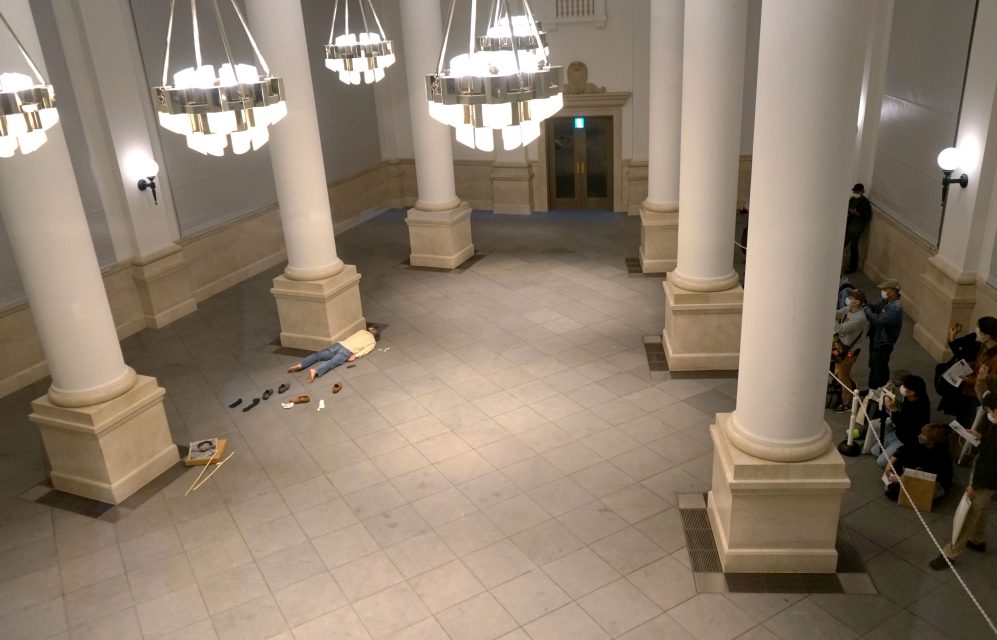
View of the Shuzo Azuchi Gulliver performance Failure due to backroom deal of “BODY” held between 16:00 and 16:30 on Friday, November 13, 2022, at the former Daiichi Bank Yokohama Branch. All images: Courtesy BankART1929
I recently went to see the Shuzo Azuchi Gulliver exhibition “Breath Amorphous” (BankART KAIKO and BankART Station, Yokohama). I had previously seen Gulliver’s work at group exhibitions, but this was my first opportunity to view so many of his pieces together in a retrospective-like format. A 14-volume catalog was also published, indicating the breadth of the show. Until now I have viewed Gulliver’s works as if in passing, so I am in no position to discuss them in their entirety. For this reason I will limit myself to writing about just one work, not a work shown at this retrospective, but the performance Failure due to backroom deal of “BODY” staged between 16:00 and 16:30 on Friday, November 13, 2022, as a related event at the former Daiichi Bank Yokohama Branch.
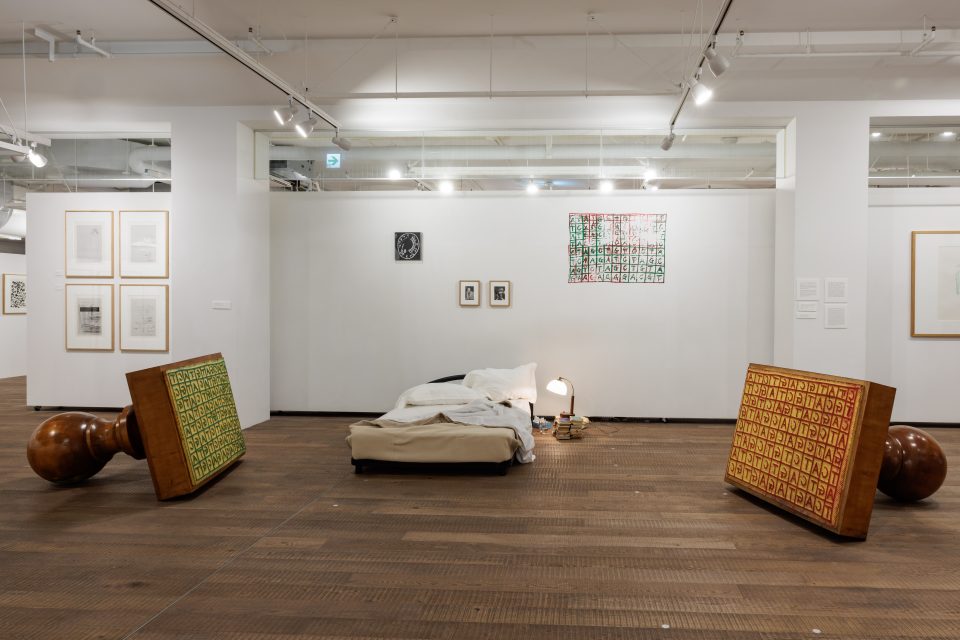
“Shuzo Azuchi Gulliver: Breath Amorphous,” exhibition view at BankART KAIKO, Yokohama, 2022.
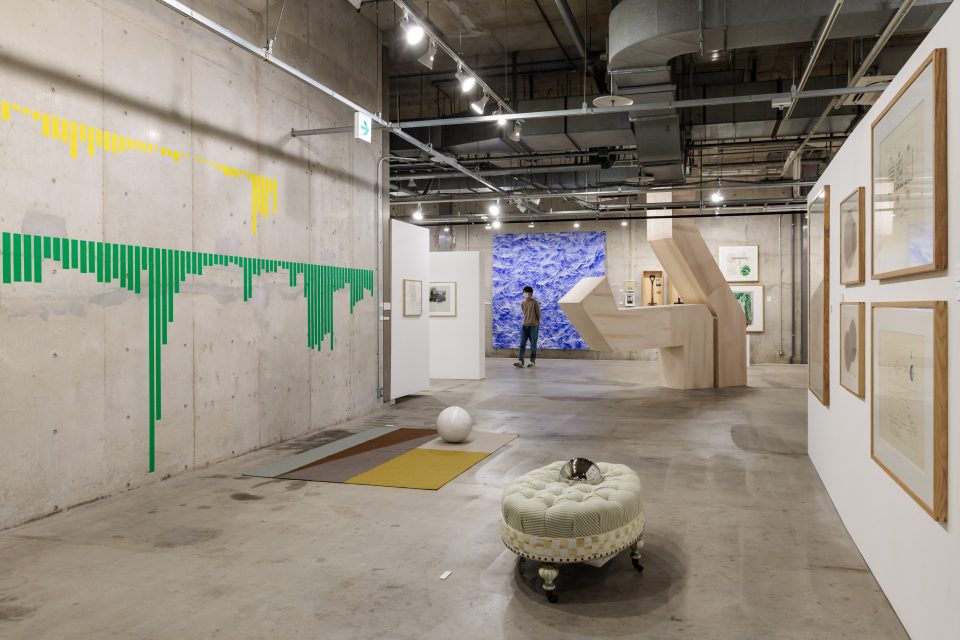
“Shuzo Azuchi Gulliver: Breath Amorphous,” exhibition view at BankART Station, Yokohama, 2022.
I first heard that this performance was planned as part of this exhibition after setting foot inside the exhibition venue. A postcard-sized flyer I was handed there included only the date, time, place and title along with a graffiti-like drawing that seemed to be a self-portrait of Gulliver. But it also contained the description, “Reenactment with a new interpretation of the performance held at Koto City Cultural Center ‘Jam Performance #5’ 1964.” So at the least, I knew that this performance was a “reenactment” of a performance staged previously at a different location, but that it was also a “new interpretation.” In other words, it was a performance that could be a reenactment while also being a new interpretation, which for me raised the question of the nature of the sameness of a performance that can be retained even after so much time has elapsed.
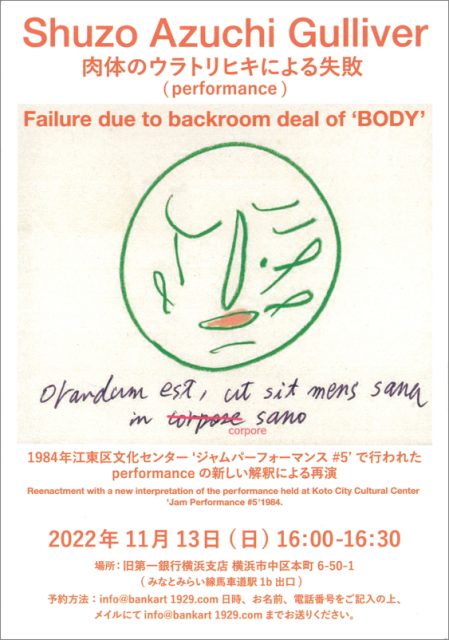
Postcard-sized flyer announcing the performance.
In painting and sculpture and installations, recreations are commonplace. With these kinds of recreations, importance is attached to using the same materials as the original (of course, using the exact same materials is impossible—it is because these have been lost that the works are being recreated—so it would be more accurate to say materials with the same physical properties are being used). In the cases of performances, however, as indicated by the fact that they were originally called “happenings” or “events,” their one-off nature is extremely important, so naturally there are problems with their “reenactment.” It is for this reason that the words “new interpretation” were used, but unlike a painting or sculpture, a performance is inseparably linked to the place and time where it occurs. Given this, it is extremely difficult to guarantee that a performance is a “reenactment” of one in the past while also being a new interpretation. So I decided to think about what the basis was for being able to “newly interpret” a performance conducted in 1984 and a performance conducted in 2022 as the same. By extension, l also thought that by doing this, I could get closer to finding out exactly “who” Gulliver the artist is and exactly “what” it is he is trying to do.
To do this, I first needed to know what kind of thing the 1984 performance was. To help me, all I had to rely on was a single sheet of A4 copy paper printed on both sides that was handed out at the entrance to the venue on the day of the performance in Yokohama in 2022. In addition to the information printed on the above-mentioned flyer, on the front it contained two photos pertaining to the 1984 performance, a text by Gulliver written right to left in katakana and two drawings. On the back were the same two photos that appeared on the front (one was enlarged, while the resolution of the other was reduced to an extreme, turning the grey portions black), to which brief captions had been added, and a relatively long printed text from an interview. This text is titled “Jam Performance #5 Body Contract: Failure due to backroom deal of BODY (19:00, November 9, 1984, Koto City Cultural Center) Interview Report,” indicating that it is an interview regarding the performance staged in 1984 carried out after the event.
However, because no source is given, it is not clear where this text originally appeared. And I have no desire to look it up. Not due to negligence, but because it is probably impossible to approach performances by artists like Gulliver with such an empirical attitude. Such performances have a more complicated “aspect,” and in fact the more one tries to get close to them with an empirical attitude, the more they tend to recede. To repeat myself, this is a “reenactment” of an impossible thing “with a new interpretation.” Given this, this flyer itself is a part of the reenactment, in which case there is no guarantee that the information contained in it is from the past. I will not go as far as saying everything is fabricated, but basically, doubting its veracity is far more productive. After all, the subject concerns “backroom deals” and “failure.”
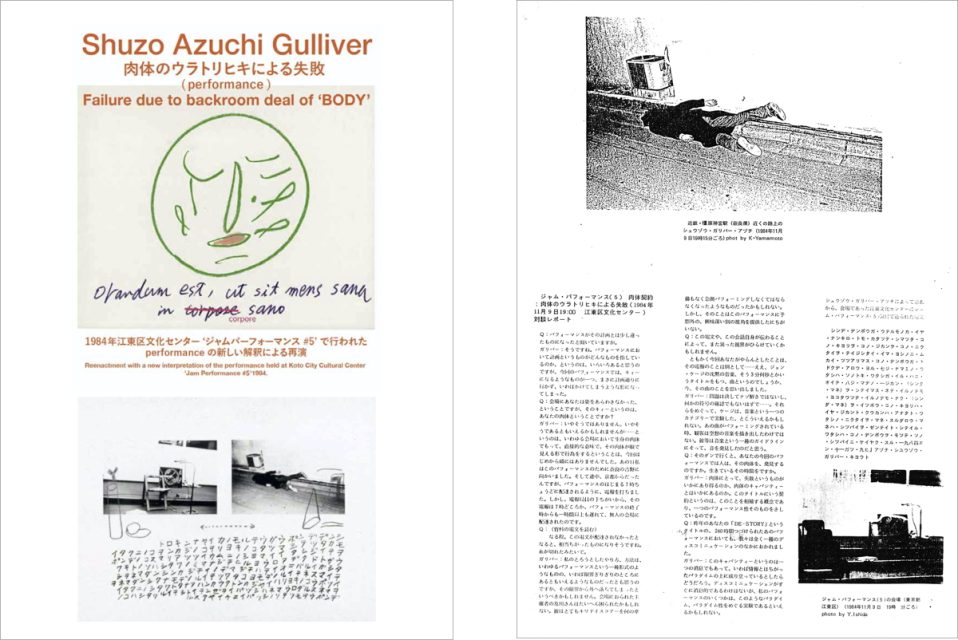
Front and back of the A4 size flyer handed out at the entrance to the venue on the day of the performance.
I first looked into whether the “Koto City Cultural Center” still exists. An internet search established that “the Koto City Cultural Center, the Koto City Regional Cultural Centers (Morishita, Furuishiba, Toyosu, Kameido, Higashi Ojima, Sunamachi) and the Koto City General Citizens’ Center are facilities established to boost the culture and promote the welfare of local citizens” and that they “provide various facilities suitable for a range of activities enabling their use widely as places where local citizens can talk and learn together, and play a role as centralized facilities that promote community activities and lifelong learning.” As it is highly unlikely that a website for such wonderful public facilities is fake (though one cannot be too careful these days), I was able to confirm as a preliminary step that the venue where Gulliver staged the 1984 performance that he recently reenacted actually exists (or existed).
But why did Gulliver choose this facility to stage his performance in the first place? Even after reading the above-mentioned “Interview Report” I am none the wiser. If I had to say, it may be because, as stated in the summary quoted above, it was a place that was able to “provide various facilities suitable for a range of activities.” Certainly, “facilities established to boost the culture and promote the welfare of local citizens” are plentiful, but “a range of activities” is setting the bar considerably higher. In fact, among the activities of local citizens, the performance Gulliver staged here in 1984 is not something that could easily have been accepted unless this “range” was quite broad. One can only appreciate anew the open-mindedness of the Koto City Cultural Center.
The Koto City Cultural Center was completed in April 1982 (it opened in June the same year), which means that Gulliver’s performance took place just two years after it opened when it was still quite new. One can only say, perhaps, that this was a propitious use of the facility. However, there are more than a few unclear points regarding the details of this “use.” Firstly, according to the above-mentioned “Interview Report,” this performance bore the title “Jam Performance #5.” Like a “jam session” in music, the “jam” refers to inviting participants who happen to be present on the spot to perform together extemporaneously (even if this is not the case, readers are welcome to imagine strawberry jam—the important thing is the mixing), so one can imagine the performance had a certain jam-like quality. The #5 suggests that at least four separate performances (by different artists?) numbered 1 through 4 may have been conducted.
In any case, I do not know whether performances were conducted as part of a series on the same November 9, 1984 (I looked it up, and it was a Friday), or whether they were numbered differently on each day. And not knowing does not bother me in the least. The fact that I am writing at length about this despite not caring is because the performance Gulliver conducted on that day was in fact not what we normally understand to be a performance. At least, this performance was not the kind of thing that could be counted as the 5th “Jam Performance” counting from number one. In other words, at this point, Gulliver’s 1984 performance is contrary to both a performance and actually being counted in numbers.
For a start, consider what appears to be the title of this “performance,” “Failure due to backroom deal of ‘BODY’—judging from the title of the interview report, as part of Gulliver’s “Body Contract.” Because these days, when I hear the word “performance” I tend to imagine an artist engaging in acts of some kind using their own body, from the outset Gulliver’s 1984 performance was intended to be an anti-performance, or rather a “failure” of performance. But not just a plain failure. A “failure due to backroom deal.” Just as I quickly backtracked a moment ago after writing “anti-performance,” Gulliver had no intention of simply rejecting conducting a performance. At the least, he intended to conduct a “backroom deal.” But according to the title, he “failed” even to do that. In other words, in the title of the performance conducted (not conducted?) in 1984, “Failure due to backroom deal of BODY,” the word “failure” describes not the performance (ie, the body), but the backroom deal.
Let us now look at how Gulliver tried to carry out this “backroom deal of BODY” in 1984’s “Jam Performance #5” and how he failed. According to the “Interview Report,” Gulliver (his body) failed to show up for “Jam Performance #5,” which was due to get underway at 19:00 at the Koto City Cultural Center. But this was as planned from the beginning, and despite the fact that a chair and microphone had been set up and other preparations made in the expectation that the artist (his body) would appear at 19:00 and conduct some kind of performance, at the scheduled time there was no sign of Gulliver and the equipment alone was left abandoned. If this was all, then all it would mean was that Gulliver had demonstrated an attitude of refusal towards existing performance. In fact, however, Gulliver was trying to secretly conduct a “backroom deal” in the space between the body that was supposed to be appearing at the venue and the site. Specifically, Gulliver, who in normal circumstances should have been heading towards the venue, was not en route from Kyoto to Tokyo, but was actually heading towards Yoshino in Nara, and at the time the performance in Tokyo was due to begin, he was on a road near Kintetsu Kashiharajingu-mae Station. He was lying face down on the pavement with his coat on and his right leg resting on the curb, and for the entire scheduled duration of the performance in Tokyo he pretended to be dead.
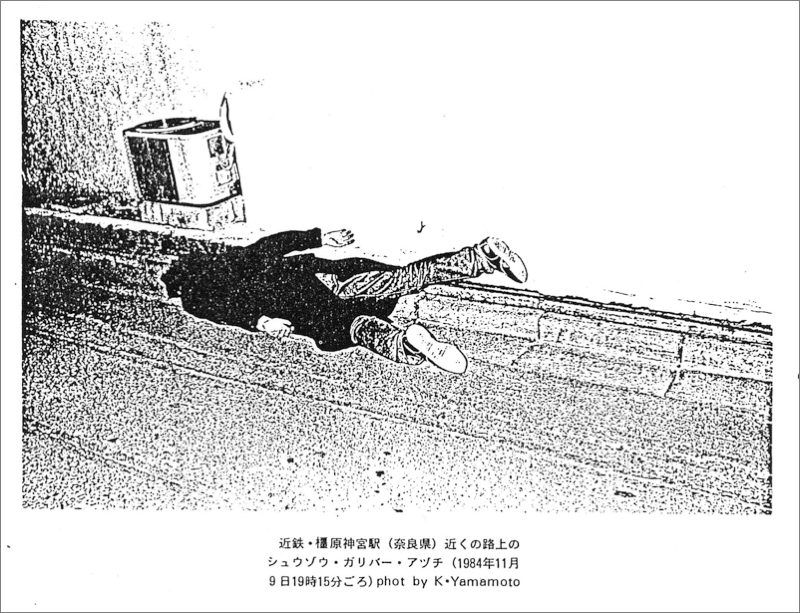
Image on the back of the handout.
So the “backroom” of “backroom deal” refers to the fact that the “body” that ordinarily should have been at the Koto City Cultural Center where Gulliver needed to be was not on “center stage” but in a “backroom” in faraway Nara. In this sense, a performance was carried out and Gulliver did nothing contrary to a performance. It was just that from the scheduled starting time to the finishing time he was not in the designated location. However, this on its own does not fulfil the “deal” between the audience and the presenter (the pre-contractual trust according to which it was expected he would come to the venue). At the least, a “backroom deal” needed to be concluded. It was with this in mind that before departing for Nara, Gulliver sent a telegram to the Koto City Cultural Center from Kyoto with instructions that it “be delivered at exactly 7 pm when the performance was due to begin.” (1) In part it read:
You cannot send a telegram when you are dead. No, I want to present this distance spoken of in so many kilometers, this time, this body. I am about to set off for Yoshino. For the one hour from seven o’clock when this telegram is due to arrive until eight o’clock, my flesh-and-blood self will “pretend to be dead.” Not sleeping or lying down, but “pretending to be dead.” At the same time, this distance, or rather this time and space, will mimic your and my body. Mimicry is premised on failure. With this telegram, I promise such a failure. November 9, 1984, Shuzo Azuchi Gulliver, Kyoto.
In the end, however, “due to a mistake by a telegraph operator” (ibid), this telegraphic message that was meant to arrive at the Koto City Cultural Center at 19:00 was delivered to the venue more than an hour after the finishing time of the performance. As a result, not only did Gulliver fail to appear before the people who had gathered at the venue, but the message also failed to arrive, meaning that the planned “backroom deal” also ended in failure. But was it really a “failure”? For a start, Gulliver had included in the telegram the words “Mimicry is premised on failure.” He even stated, “With this telegram, I promise such a failure.” What did he mean by this?
In answering this question, we first need to know exactly when the title that is today attached to this 1984 performance (in other words, the title used for the reenactment), Failure due to backroom deal of “BODY,” was decided. Because there is also a possibility that in 1984, the title conveyed in advance to the audience was simply “Jam Performance #5.” If not, and they were notified in advance that it was “Body Contract: Failure due to backroom deal of BODY,” the audience might easily have contemplated some kind of “failure” as part of Gulliver’s performance. Even if the artist had not shown up during the advertised time, and even if a telegram had not arrived, if they had been notified in advance of a failure, then a failure had been properly executed, and ultimately the performance would not have been a failure. Gulliver had written in the telegram that “Mimicry is premised on failure,” so clearly there is a possibility that failure was taken for granted (notified). However, as mentioned above, if the failure in this 1984 performance refers to the failure of the telegram to arrive on time, then it means the title was added afterwards.
However, at this stage, it is not that important which one of the above cases is true. Whether the title was decided before or after the event, there is no real difference between the failure having been notified and it occurring consequently. This is because in any event, “Mimicry is premised on failure,” and perhaps—though it may be too improbable—Gulliver deliberately arranged it so that the telegram he sent from Kyoto would arrive at the venue more than an hour after the performance was scheduled to finish in order to prove as part of the “deal” with the audience that “Mimicry is premised on failure.” At the least, there are aspects of this performance that make one think this. This would give the lie to the “failure” of the telegram operator, and the failure would become not a failure but an inevitability. Quite literally, “You cannot send a telegram when you are dead.” Only the living can send telegrams, and given that Gulliver is not dead but “pretending” to be dead as part of a deal, there is no reason that he could not have sent a telegram on time. To begin with, a telegram is a medium that would not exist were it not for its specialization above all in urgency and accuracy. Given it is such an important means of communication, would a diligent and honest telegram operator really “mistake” the delivery time of a telegram by more than an hour?
At this point, we are finally ready to discuss the 2022 “reenactment” in Yokohama. Of the things I have written thus far, the most important and the connection that can be called a clear sameness in Failure due to backroom deal of “BODY” is “Mimicry is premised on failure.” On what kind of failure is the 2022 “reenactment” (ie, mimicry) premised? Lastly, we need to think about this “failure.” If we do not, then there is no sense in a reenactment.
Having arrived at the venue, I spent the time before entering looking at the above-mentioned sheet of A4 paper that had been handed out to the audience. What I have written above is a freshly rewritten version of my prediction, made after reading during this short period the text printed on the paper, of what kind of “reenactment” would take place, which itself contains “reenactment”-like elements. It is for this reason that from the outset I focused alone on how Gulliver would fail this time in his “backroom deal of BODY.” Which is why, even after the venue opened and I saw that a barrier had been erected to prevent the audience going any further and that a male had collapsed in such a position that I could only confirm it from a certain distance, I did not conclude immediately that it was Gulliver. Certainly, his outward appearance was identical to the Gulliver who in 1984 was “pretending to be dead” on the street near Kashiharajingu-mae Station in Nara. About the only differences were the clothes and the shoes and socks (two of each) scattered around the “body.” But according to Gulliver, mimicry always invites failure, and inviting it always brings about the failure of the backroom deal with the audience. Moreover, this time the mimicry was twofold. Firstly, Gulliver was pretending to be dead. And secondly, this very pretending to be dead was a mimicry of 1984’s “Jam Performance #5.” Furthermore, with the title that had been announced in advance this time, Failure due to backroom deal of “BODY,” notice had clearly been given that at some point a failure would occur.
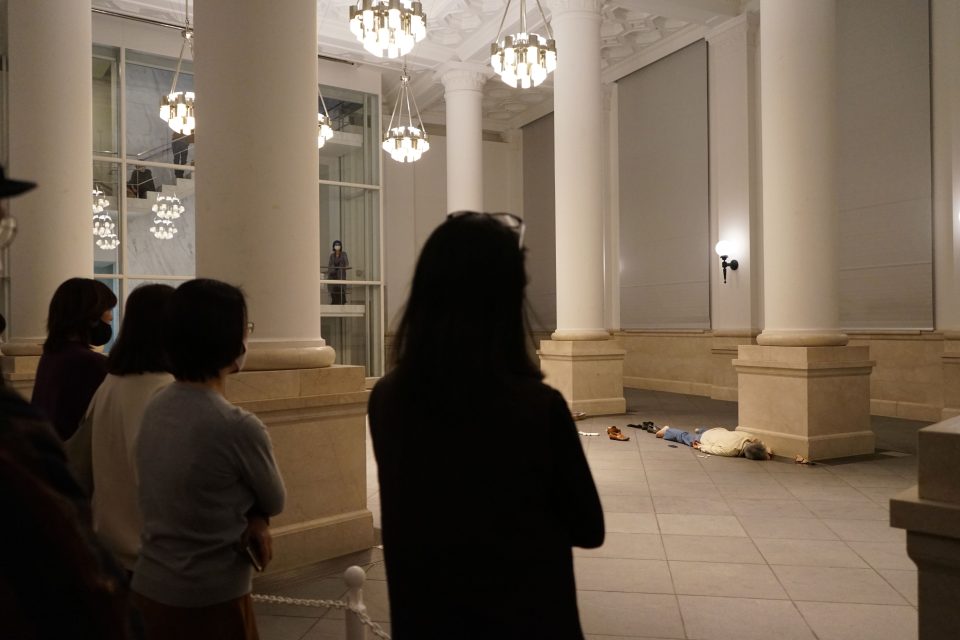
View of the Shuzo Azuchi Gulliver performance Failure due to backroom deal of “BODY” (November 13, 2022, former Daiichi Bank Yokohama Branch).
Before long, visitors noticed that in addition to the above-mentioned handout, they had also been given a copy of Gulliver’s business card when they entered the venue. The card contained his name, address, telephone number, mobile phone number and email address, with a red tick next to the mobile number. Lying on the floor beside the man who appeared to be Gulliver and who was pretending to be dead (he was lying face down, making it difficult to confirm his identity) was what looked like a mobile phone. After a while, members of the audience who had realized this began calling the number on their own phones. As expected, the mobile lying on the floor that appeared to be Gulliver’s started ringing (though the ringtone called to mind an old-fashioned black rotary-dial phone). Naturally, nobody answered. The man was pretending to be dead, and it was quite a distance from the barrier to where he was lying, so there was no way a member of the audience could have picked it up and answered for him. In the end, this situation continued for 30 minutes, and when the scheduled finishing time of 16:30 came around (the performance had begun at 16:00 sharp), the audience left the venue with the gallery staff seemingly urging us on.
So, what exactly “failed” here? The thing that immediately springs to mind is that from the audience’s point of view they failed in phoning Gulliver, while from Gulliver’s point of view he failed in answering their calls. But such things are clearly failures in anyone’s eyes. The important matter is the backroom deal, and “You cannot answer the phone when you are pretending to be dead” is no less indisputable an event than “You cannot send a telegram when you are dead.” Far from being a failure, it would be more accurate to describe it as a success. In the first place, unlike the 1984 performance, Gulliver is present in the venue. But what if Gulliver had in fact not been present? What if the person lying face down on the floor was a different person of a similar height and of similar appearance to Gulliver “pretending” to be him? But his face, critical in confirming this, was invisible and we were too far away from the figure to confirm any other details. Detailed to a degree that starkly contrasted with this, though the audience was limited, was the business card on which even Gulliver’s address and mobile phone number were printed. Would he really have handed out such detailed personal information to unspecified members of an audience? Perhaps this business card itself was “pretending” to be Gulliver’s business card. And perhaps the audience guessed wrongly that it contained Gulliver’s personal information, “assumed” on the basis of a “deal” that the man lying on the floor whose face was invisible was Gulliver and continued calling the number that could in no way enable them to communicate with the artist’s body. Come to think of it, the above-mentioned “Interview Report” contains the following exchange:
Q: In last year’s 240-hour-long performance titled DE-STORY, too, we were placed in a kind of state of complete dis-communication.
Gulliver: This capacity is also a kind of shosoku, so in a sense I am asking what would happen if things were based on a different paradigm than information. Dis-communication is not necessarily immediately shosoku-like, but several of my performances could perhaps be called experiments in such paradigms or paradigmism.(From the handout distributed at the venue for the 2022 performance in Yokohama. Emphasis added. The questioner is not identified. Perhaps it was Gulliver “pretending” to be a questioner.)
Here, the word shosoku from the Japanese title of Gulliver’s latest exhibition, “Breath Amorphous,” has at last made an appearance. The word shosoku has various meanings. It usually means something like “whereabouts,” but it is written using two Chinese characters that mean “breath” and “extinguish,” and through this association with extinguishing traces it can also be said to mean “pretending to be dead.” This is fundamentally different from “personal information” such as addresses and names, telephone numbers and email addresses. For a start, it cannot be reduced to information. That is to say, even if various pieces of information are printed on a piece of paper that is handed out, for example, as long as this is only information, we cannot help but fail to communicate with the flesh-and-blood person themselves, and even if the information written on the paper is correct as information, there is no guarantee that it will connect on a one-to-one basis the relationship between this and the man lying face down before one’s eyes. In any event, as long as Gulliver continues the act of holding his breath and pretending to be dead (ie, shosoku), we can only continue to “fail” in touching his body. And perhaps this is the sameness concerning the past, present and indeed future that is the “future of failure” connecting through reenactment the 1984 performance and the 2022 performance.
Later, I addressed this Gulliver exhibition in a seminar at the university where I work. During the seminar, to check what had become of the mobile phone number printed on the business card handed out at the performance after the performance had ended, I tried calling the number in front of my students. After a while, a man answered and said, “This is Gulliver.” Since I had already made his acquaintance, I thanked him for his recent performance and engaged in a little small talk before ending the call. There can (surely) be no mistake that it was Gulliver, but for me, even after the performance had “failed,” the fact that the phone continued to ring without Gulliver answering it seemed like “the continuation of failure = the future of shosoku,” so being able to talk with the artist almost too easily via the information handed out that day was for me the unexpected real “failure.”
1. Currently, one cannot designate the arrival time for telegrams in Japan. Due to their social value, it may have been possible in 1984, but I have put together this column above all as a piece of art criticism based on the text left behind by Gulliver himself.
Shuzo Azuchi Gulliver: “Breath Amorphous” was held from October 7 through November 27, 2022 at (BankART KAIKO and BankART Station, Yokohama.
